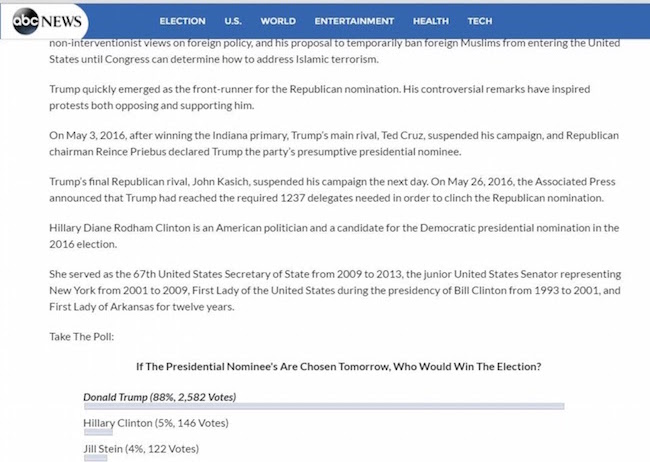It’s typically been fairly easy to describe what fake news websites are, and how they work: These sites publish stories that look and read like real news articles but are completely fake. They exist in order to earn money from ads.
That description works for many of the ever-growing number of these sites. But many of them are now evolving in order to find new ways to fool people, and to make money. Here are five things fake news sites are now doing differently.
The local viral hoax

Hoax stories of terrorist attacks, with only the city name changed, have been popping up on fake news sites recently
People tend to care more about news events which are happening in their city or town. That’s a fundamental truth, and now hoaxers are using it to their advantage. The result is what I now call the “local viral hoax”.
One approach, which I recently detailed in this story, involves scammers creating multiple copies of the same hoax article about a terrorist attack killing multiple people in a city. Each article is then edited to cite a different city, with the rest of the text and headline left exactly the same.
The hoaxers publish the articles on one or several websites and then join Facebook groups focused on the locations cited in the hoaxes. Once accepted into the group, they share the link with all the members. This ensures a hoax about, say, Chicago is seen by people who live there. Those people click on and/or share the link with others in the area, thus driving traffic to the websites hosting the hoax.
When it works well the hoax will go viral locally. If you create 10 or 15 of these articles, each about a different city, you can start to generate some decent traffic.
Another variation on the local viral hoax are the websites that publish fake stories about celebrities moving to a specific place in the US or Canada, or about a celebrity saying nice things about a city or town.
This hoax about Leonardo DiCaprio moving to Hempstead, New York has racked up over 16,000 likes, shares and comments on Facebook. And this one about Johnny Depp moving to Bethlehem, Pennsylvania has close to 50,000 Facebook interactions.
We’re likely to continue to see new variations on the local viral hoax, as it requires far less creativity than trying to come up with new hoaxes every day.
Mimicking actual news sites
Last week Donald Trump supporters began flooding a website they thought was ABC News to vote in an online poll about who they would be supporting at the US Presidential election in November. Pretty soon, Trump was winning in the poll by a landslide, and people were sharing the results on Twitter as proof that he would win in November:

Screenshot from the now defunct ABCNewsGo.co
The site, which has since been taken down but is partially archived, was a fairly convincing copy of the real ABC News website. Its domain was ABCNewsGo.co, while the real ABC News site is ABCNews.go.com
More and more fake news sites are popping up which use domain names similar to actual news sites: CNNInternationalNews.com, World-BBC-News.com, BBC-Breaking-News.gq, CBCNews.gq, and many more. Because they infringe on the trademark, and often the copyright, of real news brands these sites don’t stay online for long. But all they need is a few days and a really big hit to earn some money. Then they find a new domain name and start all over again.
Mixing in real and fake

Screenshot from News Examiner
One of the most alarming trends with fake news sites over the last year is that some of them have started mixing in articles about actual events with their hoaxes. I first saw this on long-time hoaxer Paul Horner’s site, News Examiner. As the above image shows, he’ll publish a fake story about Obama banning the Pledge of Allegiance right next to a real story about an Olympic athlete.
The reason for doing it is that some real news stories can of course bring in traffic. But more importantly, if someone sees a story on the site which they know is true, they may be more inclined to believe an utterly false one next to it. Mixing the true and the false just muddies the waters further, and may help convince people that a hoax site is credible.
Mixing satire with hoaxes
A similar trend is for sites to publish genuinely satirical news stories — think of what The Onion does — alongside fake news hoaxes. Close to two years ago, the site NationalReport.net was pumping out frightening hoaxes about Ebola in the United States to literally scare up traffic. But the owner of the site, who goes by the pseudonym Allen Montgomery, told me that lately he’s been mixing in more satirical stories.
“At NR, we have shied away from the straight fake stuff over the past year or so in favor of content more targeted to a more traditional satirical approach (which in my opinion is much more fun, and challenging, to write),” he said in an email.
That means the site will publish a fake post such as Sarah Palin being banned from Facebook for calling Black Lives Matter protesters “thugs”. And it will also do something satirical, like Sarah Palin listing pig latin as one of her spoken languages in a resume sent to Donald Trump.
New business models
The vast majority of fake news sites exist in order to earn money from display ads placed on article pages. If the hoaxes drive traffic to the site, they make money. But I’ve recently seen two other ways scammers are using fake news articles to generate revenue.
The sites hosting the fake terrorist attack hoaxes detailed above weren’t trying to make money from advertising. As I reported, they sought to do one of three things: “infect the user’s computer with malware, trick people into handing over personal information, or redirect the traffic to online gaming sites in order to earn a commission.”
As banner ads become more difficult to make money from, we can expect to see scammers try new ways of monetizing fake news.
The bottom line is that this trend toward mixing real news stories and satirical posts with hoaxes means these sites are becoming more complex for the average reader to get a handle on. Confusion reigns — and pays.
Follow First Draft on Twitter and Facebook for regular updates on social newsgathering, digital verification, best practice and more.



